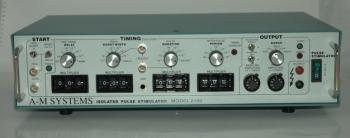Model 2100 Isolated Pulse Stimulator
Isolated current stimulator suitable for a wide range of physiological experiments. Can be controlled automatically, manually or triggered by an external signal.
- Overview
- Specifications
- Links
BEST-SELLING WORKHORSE STIMULATOR
Designed for a range of stimulation protocols, including kindling, orthodromic and antidromic stimulation, behavioral feedback, LTP/LTD, lesion formation, electrode labeling, and ultrafast timing applications.
Key Features:
- Convenient - Built-In Isolator, Constant Current or Voltage
- Powerful - ± 100 V, Up to 10 mA
- Fast - 1 µs Pulses, Every Other µs
A wide range of physiological stimulation protocols, such as behavioral feedback, LTP/LTD, lesion formation, electrode tagging, ultrafast timing applications, orthodromic/antidromic stimulation, and kindling, are well suited for the Model 2100 Isolated Pulse Stimulator.
There is no requirement for an external SIU to convert voltage pulses into constant current pulses since there is a built-in stimulus isolator circuit. The Model 2100 can be manually triggered, constantly operated (in "free-running mode"), or externally actuated by a TTL pulse from a computer or footswitch.
Functionality is shown by status and fault LEDs. Leverwheel switches with simple settings control durations and intervals.
Model 2100 isolated pulse stimulator features:
- Timing spans 1 µs to more than 15 minutes.
- Highly precise! superior to 0.02%
- Since the output is optically isolated, a costly external SIU is not required.
- Ability for Mono or Biphasic Output
- Status Indicators
The Model 2100 Isolated Pulse Stimulator, which is the best-selling device from A-M Systems, can be used as a reliable stimulator in your lab.
Pulse Train Parameters
The front panel's banks of leverwheels and rotary knobs are used to establish the desired pulse train parameters four times as follows:
- the delay period (the interval between the trigger and the initial pulse);
- a train's burst breadth;
- specific pulse rate;
- interpulse period (the length of a single pulse on/off cycle).
A timing overlap error LED indicator alerts the user if the period is set to be less than the pulse duration.
There is no further delay between the trigger and pulse output when the delay is set to "none" for convenience. A single pulse will be emitted for a single triggering event if the burst width is set to "single." This also suppresses the post-pulse delay associated with the inter-pulse period, making the stimulator retriggerable right away rather than having to wait until the conclusion of the period.
One option for choosing the pulse duration is "square," which automatically sets the duration to half the interval.
Leverwheel switches, which are far more practical than thumbwheel switches, allow for quick and simple setting of the times. Only a 10 MHz internal crystal clock with absolute accuracy better than 0.02% and timer-start jitter of ±250 ns (±2.5 µs in the 100 second range) is required for timing precision.
Amplitude
With a voltage-mode output impedance of less than 60 Ohms and a current-mode output impedance of at least 1 Megohm, the full-scale amplitude accuracy is 1%. The output pulses can be either biphasic, in which a positive pulse is followed immediately by a negative pulse, or monophasic (selectable polarity). Up to 10% of the pulse amplitude range can be separately adjusted for the baseline amplitude.
The Model 2100 includes:
- Operator's manual
- Rack mount hardware
You can also visit site of the manufacturer.


